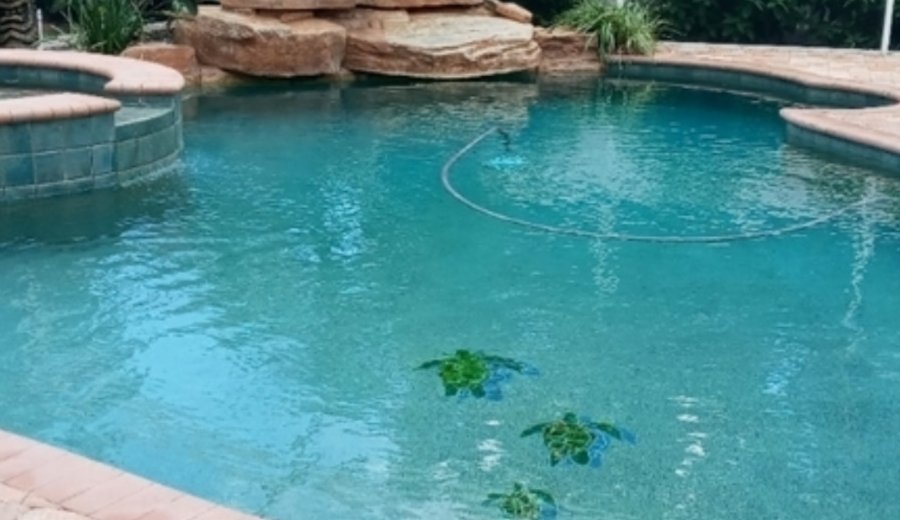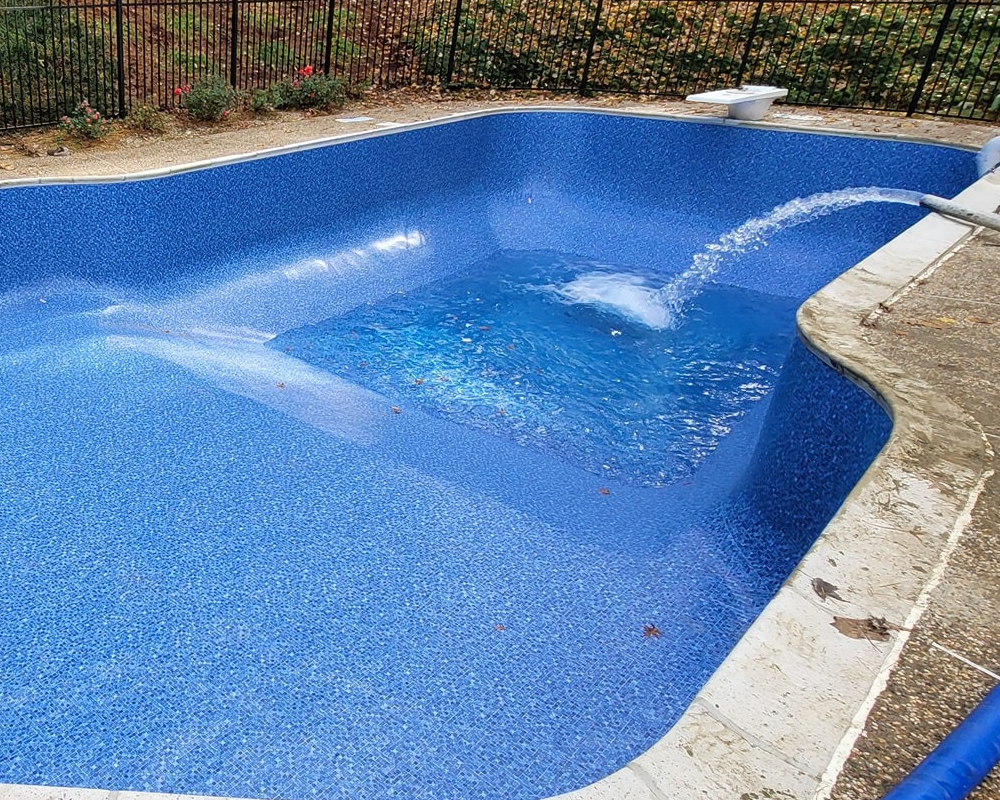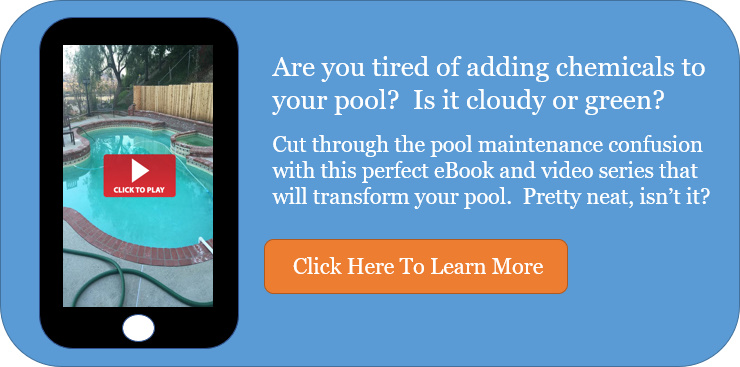- Home
- Maintenance
- Salt Water Pool Conversion
Easy Steps To Convert Your Pool To Salt Water
Many of you know I do pool inspections for people who are considering purchasing a home with a pool. When the inspection report doesn't come back as good as the buyers hoped for, without exception, they ask the same question: "Can I convert my pool to a salt pool?"
Maybe you’ve been thinking about salt water pool conversion. Over half of all pools being built today are salt water pools. So what's all the hype about? Are salt water pools better than regular chlorine pools? Well, the conversion to a salt water pool is easier than you might think. So let's read on.

What Is A Salt Water Pool?
A salt water pool is when you add the appropriate amount of salt to your pool. This saline water is then passed through a chlorine generator that produces chlorine, or more specifically, hypochlorous acid. It's this chemical that kills the organic matter in your pool. Instead of manually adding chlorine to your pool, your chlorine generator does it for you. Organic matter consists of algae spores, swimmer waste (sweat, spit, urine) grass clipping, leaves, pollen, dirt particles, and pretty much anything else that falls into your pool.
Why You Should Switch To A Salt Water Pool
Salt water pools have some benefits. so let's touch on a couple of them now.
Salt Water Pools Feel Better
There's no arguing that point. Salt pools do in fact feel much better on your skin. Think about swimming in diluted baby lotion. If you can conjure up that picture and feeling, that's what it's like swimming in a salt pool.
Salt Water Pools Have Softer Water
Just like above, salt water feels softer on your skin compared to a traditional chlorinated pool. When properly maintained, the softer salt pool water can decrease your itchy skin and red eyes when swimming.
No More Manually Adding Chlorine
Not carrying around and storing jugs and jugs of chlorine is important to some people. Believe me, they can get heavy after a while. And some people are allergic to the fumes that liquid chlorine can produce. There's also the risk of bleaching out your clothes. When you finally do your salt water pool conversion, lugging around chlorine jugs and emergency trips to the pool store become a thing of the past.
How To Prepare For Your Salt Water Pool Conversion
Fortunately there's not too much extra to do when you want to convert your pool to salt water, but there are some common questions to answer.
Should I Balance My Chemicals?
Yes, we always want the chemicals in our pool to be balanced. The main areas are the chlorine, pH, alkalinity, calcium hardness, CYA, and metals. If the order is important to you, we would go CYA, pH, chlorine, alkalinity, calcium hardness, and lastly metals. The order does matter. Effective and maintained chlorine levels kills the organic matter in the pool. We make our chlorine effective by first adjusting the CYA and pH. They're the batteries that give our chlorine the "oomph" it needs. Everything else is easy to adjust.
Should I Drain My Pool?
The short answer is no, we don't need to drain our pools prior to converting to salt water. The exception is if you've been using Baquacil or some other type of biguanide agent. Baquacil is classified as a biquanide, which is a non-bleach/halogenic product whose main oxidizing component is hydrogen peroxide.
Honestly, I'm not a big fan of Baquacil or biquanide forms of pool agents. Even more, most of the 5,000 or so real pool guys that are on my pool professionals Facebook Groups aren't either. Hydrogen peroxide simply cannot kill algae spores and bacteria faster than they reproduce. That's why we need a sanitizing agent like chlorine (sodium hypochlorite) or bromine. Those two are the only agents that I'm aware of that are recognized as pure sanitizers.

How To Choose Your Chlorine Generator
This is the biggest decision we make when we're thinking about a salt water pool conversion. How do I go about choosing and sizing my chlorine generator? What pool owners should realize is the the amount of sanitation your pool needs depends on environmental factors and usage over the course of the swimming season.
Summer, heavy bather loads, and warmer pool temperatures will require about twice the amount of chlorination compared to the off-season. The chemicals in your pool, bather load, organic matter being introduced, among other things are always changing, so your chlorine generator should be able to compensate for these variations. If you undersize your chlorine generator, you might have issues maintaining a good chlorine level.
When choosing the right chlorinator for your pool, let's keep these in mind:
- Your Pool Size - Long ago the pool industry set a standard for sizing a chlorine generator and called it Maximum Capacity. Your pool’s chlorine demand can have wild swings and variations. Given those parameters, and more, you will want to size your salt water chlorinator with a maximum capacity 1.5 times to 2 times greater than your actual pool size. I'd shoot for 2 times larger. For example, if you have a 20,000 gallon pool, then you will want to buy a chlorinator with at least a 30,000 gallon maximum capacity system. In this case, bigger IS better. You can always dial it down to meet your chlorine needs.
- Chlorinator Price - When buying such an expensive unit, most people look at the price, and that's understandable. You will want to buy a chlorinator that is both budget friendly and the best quality. Normally, you can find a quality salt chlorinator between $500 - $800. Larger pools will require larger units, thus, an increase in cost.
- Benefits & Features - Functions such as reverse polarity, flow control, sanitizing level increments, and the ability to operate at lower flow rates are important to some pool owners. Others may want to take a different approach and need only the basics. Keep in mind the more features you choose, the higher the cost will be.
Start The Salt Pool Conversion Process
You've chosen your salt chlorinator and the salt water system. Now it's time for its installation. Your chlorination system should come with a set of instructions, but this is the general process. If you're not comfortable cutting wires and plumbing, it's best to call in a qualified pool contractor.
Balance your water. The correct readings are chlorine 2 - 4 ppm, pH 7.2 - 7.8, alkalinity 80 - 120 ppm, calcium hardness 150 - 250 ppm, CYA 30 - 50 ppm. Salt water pools can have a slightly higher CYA level, up to 70 ppm. Make sure you have a good test kit like the Taylor K-2006.
- Add the right amount of salt to increase your pool's saline level. This is normally 2500 - 3500 ppm. Always check your owner's manual for the correct salinity range.
- Install the chlorinator controller (salt water control box) near your pool equipment pad, ideally on a wall. Make sure the control box is properly bonded. I've seen so many unbonded salt control boxes during my pool inspections.
- Install the salt cell into the pool plumbing. IMPORTANT: The salt water chlorinator should be the last piece of equipment in your pool plumbing.
- Connect the salt cell to the control board.
- Turn on your pool pump and look for leaks. Allow the pump motor to run for several hours. This helps circulate the water and dissolves the salt that was added to the pool.
- Check the control board for the proper lights to come on. The control panel should be showing good flow and the correct amount of salt.
- Turn on your salt chlorinator. After 8 - 10 hours you may want to test the chlorine to confirm the salt water chlorinator is working.
Maintenance On Your Salt Water Pool
Maintenance after your salt water pool conversion will be very similar to a regular chlorine pool, with a couple added tasks. Doing these will not only make your swimming pool more enjoyable, it will help lengthen the life of your pool and chlorine generator.
- Remove debris from the pool daily, or as needed.
- Backwash as needed.
- Remove debris from the skimmer and pump pot basket as needed.
- Test your chemicals on a weekly basis and add chemicals to maintain the proper levels.
- Brush and vacuum your pool on a weekly basis or as needed.
- Inspect and/or clean your chlorine cell every 3 months. This is especially true if you have hard fill water.
IMPORTANT PRO TIP: This is something that you will probably read only here. Your salt pool's pH will continually rise. The nature of the beast? Occupational hazard? Call it what you will, but this is a very important part of your salt water pool conversion. High sustained pH coupled with high sustained calcium hardness will scale up your beautiful chlorine generator. This scaling can decrease its chlorine output and shorten its life. Remember to keep some muriatic acid or dry acid on hand to maintain your pool pH level at 7.2 - 7.8
Whenever I inspect a salt pool and notice the control board is dialed up to 90% or higher, it's very safe to assume the chlorine cell is not properly working and/or has not been cleaned in some time, or there's a low salt level in the pool. For a light to medium used pool, the dial should be normally set between 20% - 40% to maintain a chlorine level at 2 - 4 ppm.
Take The Scary Out Of Salt Water Pools
A salt water pool is a great way to unwind after a hard day's work, or for that July 4th swim party/cook-out you're planning. Remember to keep up on your pool maintenance and after your salt water pool conversion, you'll be the envy of the neighborhood.
